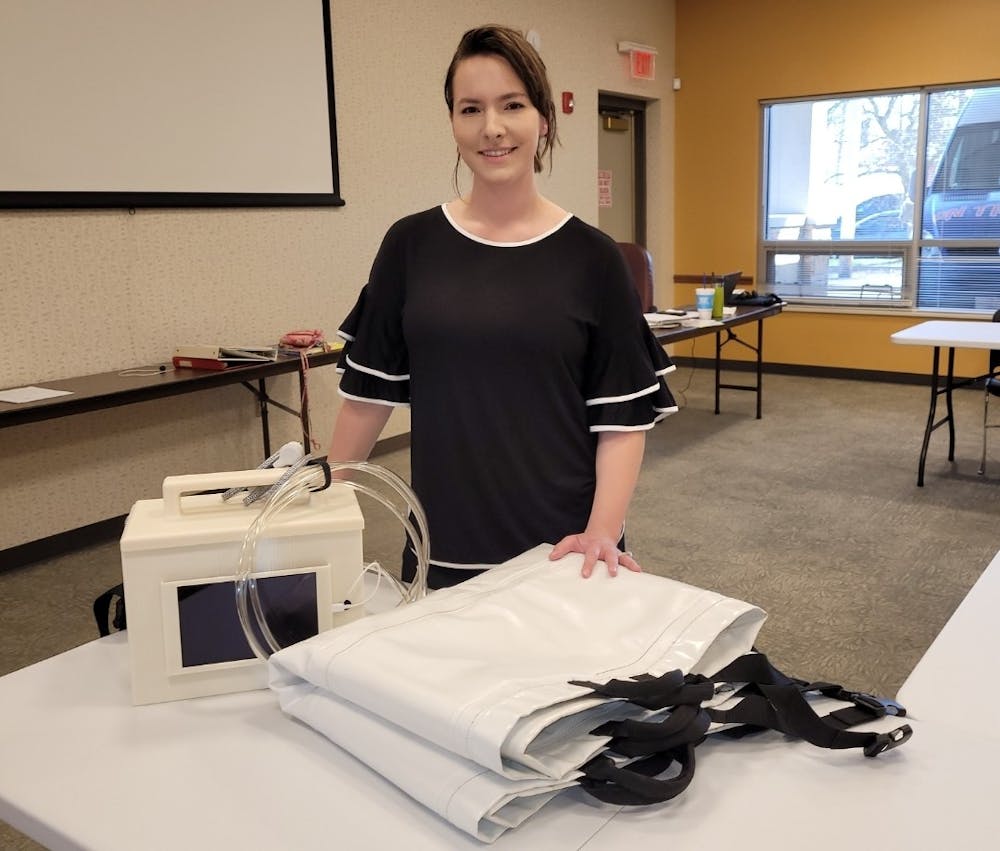IU alumnus and bus driver Morgan Miller recently acquired a patent on a medical device she created which she named the Morganleigh. The device helps patient care technicians turn patients on the bed in a more comfortable and safe way.
She said the invention became patented on Jan. 23, after four years of research and development.
Miller said she didn’t have experience in engineering prior to inventing the Morganleigh. Before switching to a general studies degree in her senior year at IU, she was a double major in psychology and business.
After graduating from IU with a bachelor’s degree in general studies, Miller said she started working as a patient care technician at IU Health Bloomington. One of her jobs at the hospital was to physically turn patients 30 degrees every two hours to ensure they would not get pressure sores or tunnel ulcers from laying on one side for too long. She did this with patients who had difficulty moving or were bedridden.
[Related: IU Kelley professors study possibilities of AI technology]
Turning a patient is a physical process that requires a patient care technician to lift the patient and place pillows under them. This procedure can be very strenuous and can cause injuries to the patient care technicians. After getting injured herself, Miller said she started designing a device that would help the medical staff.
“When I was thinking of a way to make my device, it was more just about the whole function of what I was wanting the outcome to be,” Miller said. “I wanted it to automatically turn people so that it would take the physical aspect of turning someone off the nurses and the patient care techs.”
She said after realizing her goal, within a day she knew what she was going to make.
“It was really like this enlightening thing,” Miller said. “I didn't spend months on it. I saw what I wanted in my head; from that point, I just started googling different places for fundraising.
In her search for funding, Miller said she learned about the Indiana Small Business Development Center and the Indiana Technical Assistance Program. The INTAP fund provides free assistance for startups and entrepreneurs in Indiana. Established in 2017, INTAP has given more than $2 million in funding to more than 170 businesses across Indiana through $10-15,000 investments.
“Morgan’s project was perfect for the program,” Steve Bryant, the regional director of South-Central Indiana SBDC, said. “INTAP for her, obviously, was helping with the design of the prototype, of finding the different components that go into it and then actually building it.”
Miller said she applied for INTAP two years in a row and won both years. The program gave her $12,500 and sent her to Steven Stump, Director of the Center for Applied Research University of Southern Indiana who connected her to a group of USI students that built four prototype devices. With the INTAP money and $10,000 of personal savings, she said she was also able to hire a patent lawyer.
Miller said she was denied a patent three times before finally receiving one this past January. During the process, there were times that she thought about giving up due to spending $10,000 of her own savings while having a 1-year-old daughter.
[Related: IU professor awarded $1.8 million for research on particle physics]
While in the patent process, she said Susan Carlock, the vice president of Mursix U.S., contacted her to express support for the product. Carlock, a former nurse herself, believed that the product could change the lives of both patients and patient care technicians.
“I think it’s a genius concept and an invention long overdue,” Carlock said. “I'm surprised there's not something like that already out there from an ergonomic and safety standpoint.”
She has been helping Miller connect with people who can license the Morganleigh. Miller said she wants to get a licensing deal with the medical company Hillrom.
“I would love to do a licensing deal with them, because every single bed in the Bloomington hospital is made by Hill, and they have the ability to make this really easy and fast,” Miller said.
Miller said she doesn’t yet have a licensing deal and is unsure if she wants to wait for one. However, she said she is working with Ring-co, a local company to help manufacture the air compressor and housing unit, as well as Vera Bradley for fabric patterns to sew for the device.
“It’s been four years, and I'd rather move forward on my own and start making this with all the resources I have here locally, rather than waiting on someone to say we can license this,” Miller said. “I don't want to waste any more time waiting for someone to just, like, swoop in.”
Miller is currently in the process of getting her device approved by the Food and Drug Administration. For the product to be FDA-approved, it must be proven safe and effective for patients and healthcare workers, which can be a lengthy process.
[Related: First on-campus naloxone box installed at student health center]
Even so, Miller is still very passionate about her product and its potential impact on the healthcare industry. While some would doubt their abilities due to limited experience, Miller thinks it is important not to.
“Even if you think that you're not the smartest person, you're not the best at tech, you're not the best at communication,” Miller said. “You can be none of those things and still be successful.”
CLARIFICATION: Steven Stump's title was updated to reflect his most recent position.




